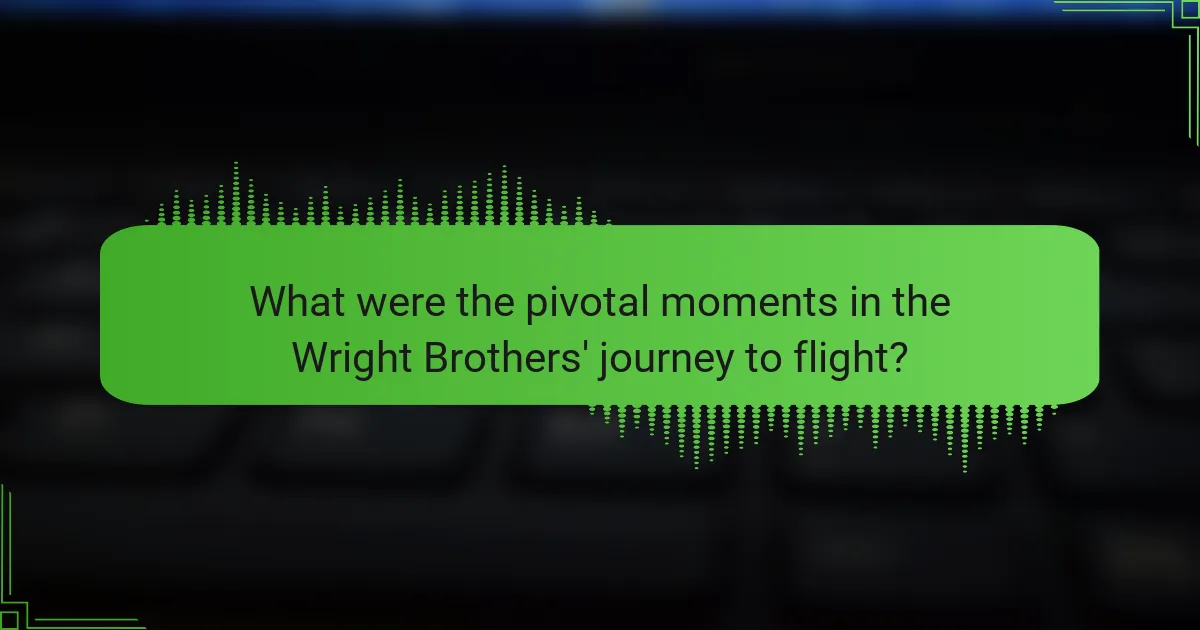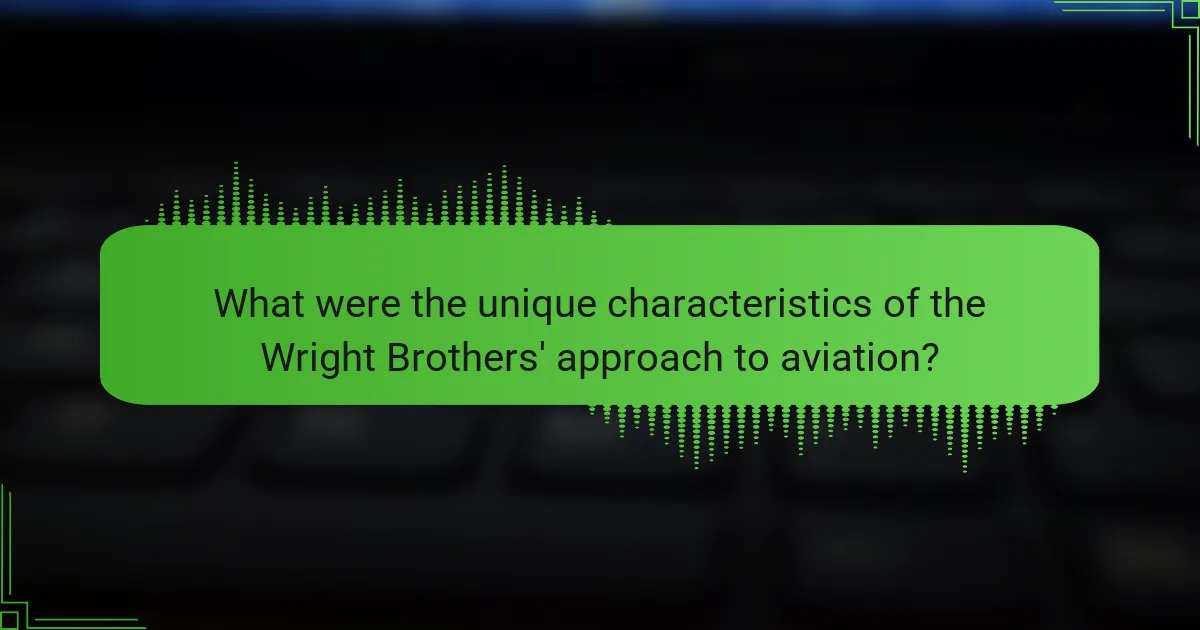The Wright Brothers transformed aviation with their groundbreaking innovations and key milestones. This article explores their first powered flight, significant technological advances like the three-axis control system, and the lasting legacy that shaped modern aviation. Their systematic experimentation and commitment to stability revolutionised flight, influencing both commercial and military aircraft development. Misconceptions about their achievements and the lessons learned from their journey further highlight their impact on aeronautical engineering today.

What were the pivotal moments in the Wright Brothers’ journey to flight?
The Wright Brothers achieved flight through several pivotal moments, including their first powered flight on December 17, 1903. Key milestones include the development of the wind tunnel for testing wing designs and the invention of the three-axis control system, which ensured stability. Their legacy is marked by the establishment of the first successful airplane manufacturing company, influencing aviation technology worldwide.
How did their early experiments shape their later successes?
The Wright Brothers’ early experiments laid the foundation for their later successes by refining their aerodynamics understanding and flight control techniques. They conducted numerous tests with gliders, which helped them discover the importance of wing shape and stability. These insights led to the development of their powered aircraft, the Wright Flyer, in 1903. Their unique approach to systematic experimentation and data collection distinguished them from contemporaries, ultimately enabling sustained flight. The brothers’ iterative process of design, testing, and modification was critical in achieving their groundbreaking milestones in aviation.
Which challenges did they overcome during their initial flights?
The Wright Brothers overcame significant challenges during their initial flights, including control, stability, and engine power. Their first successful flight on December 17, 1903, lasted only 12 seconds. They faced difficulties with lift and maneuverability, requiring multiple design iterations. The development of their 12-horsepower engine was crucial in providing sufficient thrust for sustained flight.

What technological innovations did the Wright Brothers introduce?
The Wright Brothers introduced several key technological innovations that revolutionised aviation. Their most significant advancements include the development of a three-axis control system, a lightweight engine, and a practical wing design.
The three-axis control system allowed pilots to control pitch, roll, and yaw, enhancing maneuverability. Their lightweight engine, weighing only 200 pounds, provided sufficient power for sustained flight. Additionally, their wing warping technique improved stability and control, setting the foundation for modern aircraft design.
These innovations not only enabled the first powered flight in 1903 but also laid the groundwork for future advancements in aviation technology. The Wright Brothers’ legacy continues to influence aeronautical engineering today.
How did their design of the Wright Flyer revolutionise aviation?
The design of the Wright Flyer revolutionised aviation by introducing controlled flight. Its innovative three-axis control system allowed pilots to manage pitch, roll, and yaw effectively. This marked a significant advancement over previous aircraft, which lacked such control mechanisms. The Flyer’s lightweight structure and use of a canard for stability were unique attributes that contributed to its success. As a result, the Wright Flyer laid the foundation for modern aviation design and principles.
What role did wind tunnel testing play in their advancements?
Wind tunnel testing was crucial for the Wright Brothers’ advancements in aerodynamics and aircraft design. It allowed them to gather data on lift, drag, and stability, leading to more refined wing shapes and control mechanisms. This experimental approach significantly improved their understanding of flight dynamics, ultimately contributing to the successful design of the Wright Flyer. By validating their theories through controlled testing, they achieved key milestones in aviation history.
Which materials and techniques were groundbreaking at the time?
The Wright Brothers revolutionised aviation with their use of lightweight materials and innovative techniques. They utilised spruce wood for its strength-to-weight ratio, and their 1903 Flyer featured a fabric covering that reduced drag. Their groundbreaking wind tunnel experiments refined wing shapes, enhancing lift and control. Additionally, their use of a movable rudder and a three-axis control system was pivotal in achieving stable flight.

How did the Wright Brothers’ legacy influence modern aviation?
The Wright Brothers’ legacy profoundly shaped modern aviation by establishing foundational principles of flight. Their innovations, such as the three-axis control system and wind tunnel testing, enabled controlled and sustained flight. The 1903 Wright Flyer, the first powered aircraft, demonstrated the potential of human flight, inspiring future advancements. As a result, their pioneering work laid the groundwork for the development of commercial aviation, military aircraft, and aerospace technology. Their legacy continues to influence aviation safety standards and engineering practices today.
In what ways did their work inspire future aviators and engineers?
The Wright Brothers inspired future aviators and engineers through their groundbreaking achievements in flight. Their development of the first successful powered aircraft established fundamental principles of aerodynamics and control. Innovations such as the three-axis control system became foundational for modern aviation design. Their emphasis on experimentation and iterative design fostered a culture of innovation that continues to influence aerospace engineering.
Which institutions honour their contributions to flight?
Several institutions honour the Wright Brothers for their contributions to flight. Notable examples include the Smithsonian National Air and Space Museum, which houses the original Wright Flyer, and the National Aviation Hall of Fame, recognising their pioneering achievements. The Wright Brothers National Memorial in North Carolina commemorates their historic first flight. Additionally, various universities and aviation organisations celebrate their legacy through awards and educational programmes.

What were the unique characteristics of the Wright Brothers’ approach to aviation?
The Wright Brothers uniquely approached aviation through systematic experimentation and a focus on control. They emphasised the importance of balance and stability, which led to the development of the first successful powered aircraft. Their innovative use of wind tunnels for testing airfoil designs was groundbreaking. Additionally, they prioritised practical application by building their own engines, showcasing their commitment to self-sufficiency in aviation technology.
How did their collaboration as siblings enhance their innovation?
The collaboration between the Wright brothers significantly enhanced their innovation by combining their unique skills and perspectives. Wilbur’s analytical approach complemented Orville’s practical skills, fostering a dynamic partnership. Their shared vision led to groundbreaking advancements in aerodynamics and flight control. This synergy was crucial in achieving their first powered flight in 1903, marking a pivotal moment in aviation history. Their ability to communicate openly and challenge each other’s ideas further propelled their innovative spirit.
Which personal philosophies guided their pursuit of flight?
The Wright Brothers were guided by principles of perseverance, innovation, and a belief in the power of experimentation. Their philosophy emphasised hands-on learning and iterative design, leading to key advancements in flight technology. They viewed failure as a stepping stone to success, which fostered their relentless pursuit of powered flight. This mindset not only propelled their achievements but also laid the foundation for modern aviation.

What are the common misconceptions about the Wright Brothers?
Many misconceptions exist about the Wright Brothers, primarily regarding their achievements and contributions. A common belief is that they were the first to invent the airplane, but several inventors made significant advancements before them. Another misconception is that their success was solely due to their own efforts; in reality, they built upon the work of others. Additionally, some think their first flight was a long-distance journey, while it was actually only 120 feet. Misunderstandings also persist about their motivations, with many believing they sought fame rather than a passion for flight. Lastly, the notion that they faced no competition is incorrect, as they were part of a broader movement in aviation innovation.
How do their achievements compare to other early aviation pioneers?
The Wright Brothers’ achievements in aviation are unparalleled, particularly their first powered flight in 1903. They significantly advanced aerodynamics and control mechanisms, setting foundational standards.
| Pioneer | Key Achievement | Year | Unique Contribution |
|——————–|—————————|————-|————————————|
| Wright Brothers | First powered flight | 1903 | Control of pitch, roll, and yaw |
| Alberto Santos-Dumont| First public flight | 1906 | Public demonstration of flight |
| Glenn Curtiss | First practical seaplane | 1911 | Innovations in hydroplane design |
| Louis Blériot | First flight across the English Channel | 1909 | Pioneered international aviation |
| Igor Sikorsky | First successful helicopter| 1939 | Development of rotorcraft technology|
What myths have emerged surrounding their flights?
Many myths surround the Wright Brothers’ flights, often exaggerating their achievements. Common misconceptions include the belief that they were the first to invent flight or that their success was solely due to their own innovations. In reality, they built upon existing knowledge and collaborated with others in the field. Additionally, some myths suggest their flights were flawless, while in truth, they faced numerous failures and setbacks. Their legacy is a complex blend of innovation, perseverance, and collaboration.

What practical lessons can be learned from the Wright Brothers’ experiences?
The practical lessons from the Wright Brothers’ experiences emphasise perseverance, innovation, and teamwork. Their iterative approach to problem-solving led to significant technological advances in aviation. They learned the importance of detailed experimentation and data analysis, which ultimately contributed to their success. Additionally, their ability to adapt and learn from failures highlights the value of resilience in achieving goals.
What strategies did they use to persist in the face of failure?
The Wright Brothers used resilience, iterative experimentation, and collaboration to overcome failure. They embraced setbacks as learning opportunities, refining their designs based on each flight’s results. For example, after multiple unsuccessful attempts, they improved their control mechanisms, leading to the first powered flight in 1903. Their commitment to innovation and teamwork was crucial in achieving their goal of human flight.
Which best practices can modern innovators adopt from their journey?
Modern innovators can adopt persistence, iterative design, and collaboration from the Wright Brothers’ journey. Their commitment to overcoming failures fostered resilience. They emphasised continuous improvement through experimentation, leading to significant technological advances. Additionally, their collaboration showcased the importance of teamwork in achieving complex goals.


